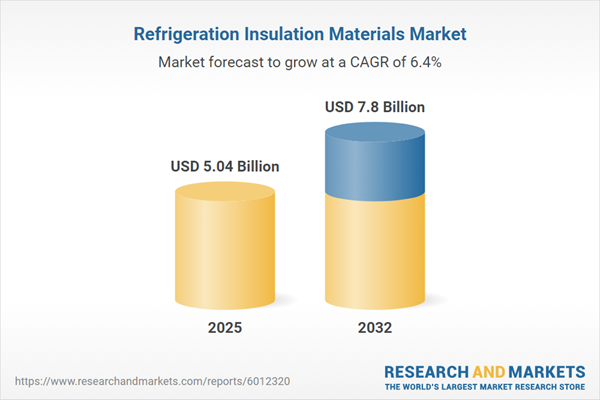Speak directly to the analyst to clarify any post sales queries you may have.
Senior executives in the refrigeration insulation materials market must address evolving sustainability expectations, stricter regulatory standards, and the adoption of digital tools across industries. Clear strategy and streamlined procurement processes are essential to secure operational resilience and competitive positioning as the sector adapts to new global imperatives.
Market Snapshot: Refrigeration Insulation Materials Market
The refrigeration insulation materials market is positioned for steady expansion, with forecasts showing growth from USD 4.73 billion in 2024 to USD 5.04 billion in 2025 and projections reaching USD 7.80 billion by 2032, reflecting a compound annual growth rate (CAGR) of 6.44%.
This outlook is driven by a broad shift to energy-efficient thermal management, a move toward sustainable building codes, and rising client demands for products prioritizing durability and value. Industry leaders are investing in improvements to material science, maximizing process automation, and integrating compliance necessities. Ongoing digital transformation and advanced sourcing strategies help support continuity in the face of supply network complexities.Scope & Segmentation
- Material Types: Expanded polystyrene, extruded polystyrene, glass wool, phenolic foam, polyurethane foam, and rock wool are chosen for their environmental adaptability and cost efficiency in both new construction and retrofit projects.
- Applications: Solutions span cold storage, commercial and residential refrigeration, refrigerated transport (including trucks, rail, and containers), cold rooms, and walk-in freezers, each focused on reliable temperature maintenance and compliance.
- End Use Industries: The chemical, HVAC, food and beverage, and pharmaceutical sectors require insulation to maintain hygiene, ensure safety, and deliver tightly controlled thermal environments—key factors for effective supply chain outcomes.
- Insulation Forms: Options include board, loose fill, various panel formats (such as PIR and sandwich types), pipe insulation, and both closed and open cell spray foams. These ensure solution flexibility across standard and complex build requirements.
- Distribution Channels: Direct sales, distribution partners, and retail outlets are aligned to support global procurement objectives and local sourcing needs, maximizing supply assurance and responsiveness.
- Geographic Coverage: The Americas, Europe, Middle East and Africa, and Asia-Pacific regions each feature unique regulatory conditions and modernization drivers, requiring adaptable supplier relationships and tailored product solutions.
- Companies Profiled: Dow Inc., BASF SE, Huntsman Corporation, Covestro AG, Armacell International S.A., Recticel NV, Kingspan Group plc, Owens Corning Corporation, Rockwool International A/S, and Johns Manville Corporation are acknowledged for investment in research, performance, and technology leadership.
Key Takeaways: Refrigeration Insulation Materials Market
- Sustainability is integrated into procurement and lifecycle planning, reflecting organizational commitment to reputation management and long-term market stability.
- Procurement teams are building transparency and strengthening collaboration with suppliers to manage complex compliance requirements and protect business continuity.
- Innovative insulation solutions, such as advanced foams and aerogel-based materials, enable organizations to handle intricate retrofit projects and meet higher compliance thresholds.
- Digital transformation, utilizing IoT connectivity and digital twin technology, provides enhanced operational oversight by enabling precise temperature monitoring and energy optimization across logistics workflows.
- Regulatory adherence is critical, with specialized applications—for example, chemical resistance or hygiene in pharmaceuticals—demanding customized insulation approaches to maintain reliability and consistent delivery.
Tariff Impact on Supply Chains
Amended tariffs in the United States have led to higher import costs for insulation materials. In response, top suppliers are prioritizing regional sourcing and nearshoring practices to improve supply chain resilience and boost local operational continuity. Collaboration through localized supply networks enhances agility in addressing evolving regulatory and operational requirements.
Methodology & Data Sources
This report blends triangulated research from industry publications, direct engagements with manufacturers and users, and regulatory insights. Validation by third-party consultants and in-depth case evaluations ensure the foundation needed for confident executive decision-making.
Why This Report Matters: Refrigeration Insulation Materials Market
- Provides senior decision-makers with actionable guidance on regulatory dynamics, supplier approaches, and key developments in insulation material technology central to efficient operations.
- Prepares organizations to actively manage evolving supply chain challenges and ensure continuous access to high-quality insulation solutions in pivotal industry segments.
- Supplies benchmarks and compliance-aligned best practices to help executives design robust, forward-thinking business strategies.
Conclusion
This analysis guides executive teams in strengthening strategies, building operational resilience, and staying attuned to shifting trends across the refrigeration insulation materials sector.
Additional Product Information:
- Purchase of this report includes 1 year online access with quarterly updates.
- This report can be updated on request. Please contact our Customer Experience team using the Ask a Question widget on our website.
Table of Contents
3. Executive Summary
4. Market Overview
7. Cumulative Impact of Artificial Intelligence 2025
Companies Mentioned
The companies profiled in this Refrigeration Insulation Materials market report include:- Dow Inc.
- BASF SE
- Huntsman Corporation
- Covestro AG
- Armacell International S.A.
- Recticel NV
- Kingspan Group PLC
- Owens Corning Corporation
- Rockwool International A/S
- Johns Manville Corporation
Table Information
| Report Attribute | Details |
|---|---|
| No. of Pages | 191 |
| Published | November 2025 |
| Forecast Period | 2025 - 2032 |
| Estimated Market Value ( USD | $ 5.04 Billion |
| Forecasted Market Value ( USD | $ 7.8 Billion |
| Compound Annual Growth Rate | 6.4% |
| Regions Covered | Global |
| No. of Companies Mentioned | 11 |









